Ming Tombs (tombs underground palace and mausoleum of Emperor)
Ming Tombs are emperor and empress's mausoleum grave groups in the age of Ming. Emperor's mausoleum grave of 13 generations is here. A fixed mausoleum in this is excavated and the inside has been opened to the public as an underground palace. It is a part of World Heritage "Emperor grave group of Ming and Qing Dynasties".
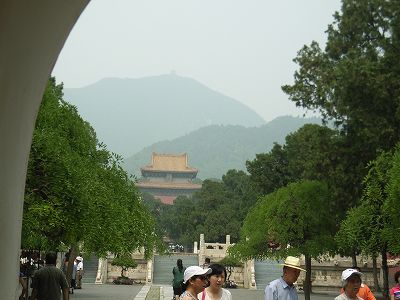
It has gone for the cheap trip to Beijing that the Yomiuri travel recruited for four days. It came round five World Heritage of "Ming Tombs", "Great Wall", "Summer Palace", "National Palace Museum", and "Temple of Heaven Park".
Here is a fixed mausoleum of Ming in 13 mausoleums. There are a lot of trees of "Chinese scholar tree" when coming here. It grows up as the branch hanging down just like the osier and the weeping cherry, etc.
This branch looks like dragon's fingernail. Dragon's fingernail was liked in China, and planted in emperor's residence well.
Anyway, because it is vast land, physical strength is needed for sightseeing. You will go with sport-type shoes.
Guide of Ming Tombs (fixed mausoleum and underground palace)
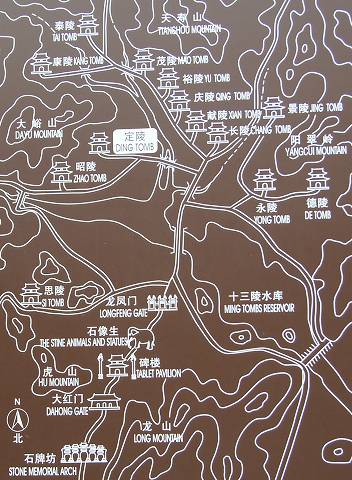
| Address |
It is in the Beijing City Shohei district and the foot in the natural term of existence mountain of the branch in the swallow mountain. |
|---|---|
| Traffic |
It is about 50km from the center of Beijing City to the northwest. |
| With the history Feature |
The mausoleum grave of 13 people lies scattered from 3 generation emperor in the age of Ming at the time of beginning of the 15th century to 16 generation emperor. The feature of this fixed mausoleum is an underground mausoleum grave made in about 30m in the underground. |
This figure is a layout drawing of Ming of 13 mausoleums. At six pillars and five gates, the first building in the south end of three mausoleums is "Stone monument Tsutsumi. "There is "Large bright red gate" with three gates in the north, and this is a front gate in the mausoleum garden. There is "Mausoleum garden" that is called Ming Tombs in these places of the north about 7km. The area are about as much as 40 square kilometers and is very vast.
There were 16 emperors in all in 276 years of the age of Ming. 13 emperors in that are buried in this natural term of existence mountain.
Ming Tombs center on "Length mausoleum", and 12 additionally mausoleum graves are scattered in the circumference. The size of the mausoleum grave is different everything, and the historical background of emperor's living period, the lifestyle, and the character, etc. are understood from the scale.
Underground palace in fixed mausoleum (coffin floor)
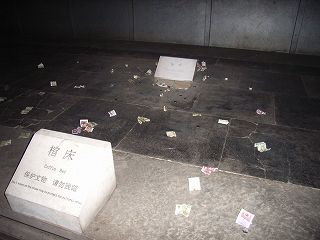
This is a coffin floor where emperor's coffin was enshrined in an underground palace in a fixed mausoleum. There are forward a small hole of brick about one, and the soul from here seems to ascend to heaven underground writing, "Kanai" in the interior.
A lot of notes were thrown out to surroundings of an underground palace (coffin floor) as a money offering mentioned in Japan. The offertory box is not, and is thrown out to ground like Japan. It is the very unsightly one. How if the offertory box is put?
These underground palaces are combined in 1195 square meters in a total area, former lord, inside lord, left distribution lord, right distribution lords, and post-lord's (empress) five rooms. An underground palace completely has neither the pillar nor the beam, and the ceiling is 7-9.5m height and union of the stone to the arch type.
Underground palace in fixed mausoleum (coffin and grave goods)
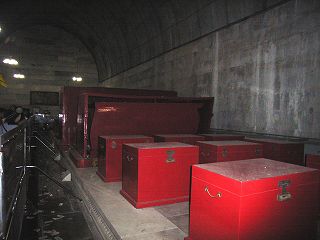
The coffin etc. are enshrined as a post-lord here. It is emperor and two empresses' coffins that the interior of this photograph is large. They are 24 boxes where the this side small size put grave goods. However, these are all replicas.
A valuable, historical material like valuable grave goods and remains, etc. seems to have been discovered from this underground grave so far by several thousand points. All these underground graves are made for a floor, a wall, and a high ceiling from the marble.
Moreover, the making is precise and the stone is piled up accurately as for the wall. Moreover, the ceiling is a splendid arch. It is interested though it doesn't know how to have made it.
It is said that the construction of a fixed mausoleum where this marble was luxuriously used becomes later years, and the finance of Ming was made to be stringent.
Underground palace in fixed mausoleum (empress's seat)
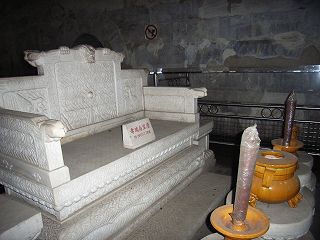
Three chairs of the emperor made of the white gem were being put by a lord in an underground palace. The Chinese phoenix and the dragon are sculptured to emperor's chair. This is a seat of the empress made from the marble. It is the very splendid one.
When an underground palace (underground mausoleum grave) was completed, the emperor and the parties concerned seem to have held the feast here for days how many. It is not thought the feast with the grave in Japan.
I hear that the jewel, precious metals, furniture, and furnishing goods, etc. that Red Guard demolished many of cultural heritages of this mausoleum grave at Cultural Revolution, and had been supplied to the redish black room were taken away. At this time, emperor and empress's remains seem to have been burnt out.
Underground palace in fixed mausoleum (exit)
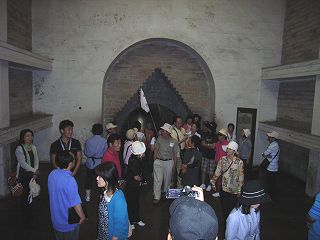
Archeologists started prospecting for a fixed mausoleum in 1956 according to information written in the one like the stone monument excavated from the vicinity of the entrance. The character "If three height five shaku was taken ahead by 16 height, it is stone from this stone to the under of the treasure" seems to have been engraved to the stone monument. This gate of the arch type to enter the grave room was discovered thick in the impregnable wall through years of about one year.
This is the entrance though it is an exit of the visit now. It seems to have taken days how many to remove the stone in this side of the arcuate gate seen in the interior. The arch in this side is the one having made it later. There were here as many as 27m in the underground, and making, and excavating it were very serious.
There was a door of the big stone made from the marble in this interior. The device lightly opened was done though it was large and was a heavy door. Moreover, the bolt of the stone assumed to be close so as not to open the door of an underground palace from the outside (bolt) was exhibited. I am just surprised at a construction technology at that time.